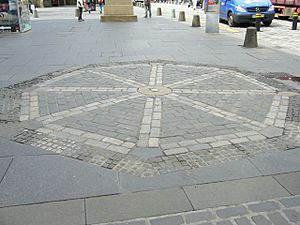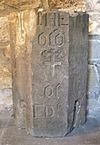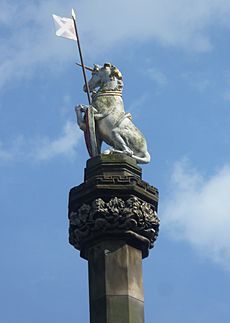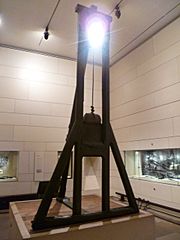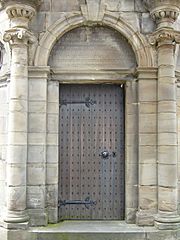Mercat Cross, Edinburgh facts for kids

The Mercat Cross of Edinburgh is a market cross, the structure that marks the market square of the market town of Edinburgh. It stands in Parliament Square next to St Giles' Cathedral, facing the High Street in the Old Town of Edinburgh.
Description and history
The current Mercat Cross is of Victorian origin, but was built close to the site occupied by the original. The Cross is first mentioned in a charter of 1365 which indicates that it stood about 45 feet (14 m) from the east end of St. Giles'. In 1617 it was moved to a position a few yards (metres) down the High Street now marked by "an octagonal arrangement of cobble stones" (actually setts). This is the position shown on Gordon of Rothiemay's map of 1647 (see external link below).
In 1756, the Cross was demolished and parts of the pillar re-erected in the grounds of Drum House, Gilmerton. A monument now stands there and on it a plaque that reads "Erected in memory of the old Mercat Cross of Edinburgh which stood at The Drum from 1756 to 1866. This Monument was erected November 1882". Five of the eight circular medallions featuring sculpted heads from the understructure of the original cross were eventually secured by Sir Walter Scott who incorporated them into the garden wall of his house at Abbotsford in the Scottish Borders.
In 1866 the pieces of the cross from Drum House were reassembled on a new stepped pedestal on the east side of the north door of St Giles. (That base now supports the Canongate Cross.) Because the pillar had been broken during demolition in 1756, its height was reduced after reassembly from 19.7 to 13.9 feet (6 to 4.25 m) and its girth made thinner. In 1885 it was placed on a new octagonal drum substructure at its current location, 24 feet (7.3 m) south of the original pre-1617 position. This was designed by Sydney Mitchell and paid for by William Gladstone, M.P. for Midlothian from 1880 to 1895, whose father and grandfather hailed from Edinburgh. The sculpted heads on the original cross were replaced by the royal arms of Britain, Scotland, England and Ireland, the burgh arms of Edinburgh, Leith and the Canongate, and the arms of the University.
The original shaft was replaced when the Cross underwent extensive renovations in 1970. A study of the stonework, commissioned by the Royal Commission on the Ancient and Historical Monuments of Scotland (RCAHMS) and carried out in 1971, concluded that: embedded in the current structure are two pieces of an old shaft stone, that the capital belongs to the first part of the 15th century and that the unicorn is an 1869 reproduction of its predecessor on the 1617 cross based upon a description in contemporary accounts.
The tympanum above the wooden studded door on the east side of the Cross bears the following Latin inscription composed by William Gladstone, in incised Gothic letters:
DEO . GRATIAS / VETVSTVM . MONVMENTVM . CRVCEM . BVRCI / EDINENSIS . PVBLICIS . MVNERIBVS . AB . ANTIQVO . DICAM / CARMINE . TAM . EXIMIO . QVAM. VIRILI . A . SVMMO . HOMINE . GVATRO / SCOTT . ET . VINDICATAM . ET . DEFLETAM . PRAESVLIBVS / MVNICIPII . PERMISSV . REDINTEGRANDAM . CVRAVIT . GVL . E . GLADSTONE / STIRPE . ORIVNDVS . PER . VTRAMOVE . LINEAM . PENITVS . SCOTICA / A . S . MDCCCLXXXV . DIE . NOVEMBRIS . XXIV
{{quote|Thanks to God. This ancient monument, the Cross of Edinburgh, which of old was set apart for public ceremonies, having been utterly destroyed by a misguided hand A.D. MDCCLVI, and having been avenged as well as lamented, in song alike noble and manful, by that great man Walter Scott, has now, by favour of the Magistrates of the City, been restored by William Ewart Gladstone, who claims through both his parents a purely Scottish descent. [24th] November 1885.
Proclamations, burnings and punishments
As elsewhere in Scotland, important civic announcements were made at the mercat cross. In Edinburgh, royal and parliamentary proclamations that affected all of Scotland were publicly read. The practice of announcing successions to the monarchy and the calling of parliamentary general elections is continued to this day by heralds of the Lord Lyon King of Arms.
After the surrender of the "Queen's Men" ended the "Lang Siege" of Edinburgh Castle William Kirkcaldy of Grange, his brother James and the two jewellers Mossman and Cokke, who had been minting coins in the Queen's name inside the castle, were hanged at the Cross on 3 August 1573.
It is also recorded that, "Upon 2d day of December, 1584, a baxter's boy [baker's apprentice] called Robert Henderson, (no doubt, by the instigation of Satan) desperately put some powder and a candle in his father's heather-stack, standing in a close opposite to the trone of Edinburgh, and burnt the same with his fathers house, which lay next adjacent, to the imminent hazard of burning the whole town.
Alastair MacGregor of Glen Strae, chief of the outlawed Clan Gregor was executed at the Cross along with eleven of his kinsmen in January 1604. A contemporary recorded that "Himself being Chieff, he wes hangit his awin hicht aboune [own height above] the rest of hes freindis".
Six days after the execution of King Charles I, the Scottish Estates proclaimed his son Charles II at the Cross on 5 February 1649, thus directly challenging the English Parliament's acceptance of the Commonwealth. The Cross was the place of execution of the Royalist leaders George Gordon, 2nd Marquis of Huntly on 22 March 1649 and James Graham, 1st Marquis of Montrose on 21 May 1650.
Following occupation by the English Parliamentary Army, the proposal to incorporate Scotland into the Commonwealth was proclaimed at the Cross on 4 February 1652, followed three days later by the symbolic act of hauling down the King's Arms and ceremonially hanging them on the public gallows. In May 1654, General George Monck, the English Military Governor of Scotland, was present for the reading of two proclamations delivered at the Cross, the first declaring Oliver Cromwell to be the Protector of England Ireland and Scotland, and the second confirming Scotland's union with the Commonwealth of England. This union ended with the Restoration of the monarchy in 1660.
Soon after the Restoration four men were condemned to death for high treason and executed at the Cross: Archibald Campbell, 1st Marquis of Argyll was beheaded by the Maiden on 27 May 1661; James Guthrie and Captain William Govan were hanged on 1 June 1661; and Archibald Johnston, Lord Warriston was hanged on 22 July 1663. Guthrie's The Causes of the Lord's Wrath and Samuel Rutherford's Lex, Rex, regarded by the Monarchy as dangerously seditious tracts, had been burned at the Cross by the common hangman in 1660.
The Marquis of Argyll's son Archibald Campbell, 9th Earl of Argyll was executed at the Cross on 30 June 1685 for attempting to instigate a rising in Scotland to coincide with the Monmouth Rebellion.
On 10 December 1688, a mob, having broken into the private chapel of King James VII at Holyrood Abbey and torn down the woodwork, carried it to the Cross where it was burned along with an effigy of the Pope.
In July 1725, amidst the Malt Tax Riots, Robert Dundas's The Petition of the several Brewars in and about Edinburgh under subscribing (Edinburgh: n.p., 1725) was brought to the Cross to be read aloud.
On 18 September 1745, the "Young Pretender" Charles Edward Stuart had his father proclaimed King James VIII of Scotland and himself Regent at the Cross. According to Robert Chambers in his History of the Rebellion of 1745, "The ladies, who viewed the scene from their lofty lattices in the High Street, strained their voices in acclamation, and waved white handkerchiefs in honour of the day", but another history claims that "few gentlemen were, however, to be seen in the streets or at the windows, and even among the common people, there were not a few who preserved a stubborn silence". Following the Prince's defeat the following year at Culloden, the Jacobite colours captured in the battle were ceremoniously burned at the Cross.
The Mercat Cross medallions at Abbotsford
The middle photo shows the Edinburgh Burgh Arms. The heads have never been identified.


